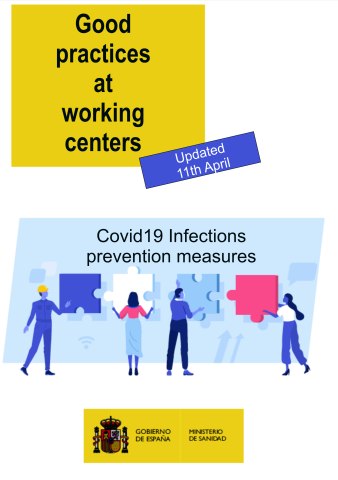GOOD PRACTICES AT WORKCENTER. GOVERNMENT RECOMMENDATIONS

Measures for the prevention of COVID-19 infections
OPERATION GUIDE TO FACE THE COVID19 AT WORK (SPANISH) (clickar for reading or download)

1. If you have any symptoms (cough, fever, shortness of breath, etc.) that could be associated with COVID-19, you should not go to work and you must contact the COVID-19 service telephone number in your autonomous community or with your center. primary care and follow their instructions. You should not go to your job until they confirm that there is no risk for you or for others. See the decalogue of how to act in case of symptoms here.
2. If you have been in close contact (cohabitants, relatives and people who have been in the same place as a case while the case had symptoms at a distance of less than 2 meters for a time of at least 15 minutes) or you have shared space without saving the interpersonal distance with a person affected by COVID-19, you should not go to your workplace, even in the absence of symptoms, for a period of at least 14 days. During this period, you should monitor for signs of the disease.
3. If you are vulnerable due to age, being pregnant or having previous medical conditions (such as high blood pressure, cardiovascular disease, diabetes, chronic lung diseases, cancer or immunosuppression), you will not have to go to the workplace. In the event that you cannot perform your tasks remotely, you should contact your doctor to prove, if applicable, that you must indeed remain in a situation of isolation for work purposes and, if so, it will be considered a situation assimilated to an accident of work for the economic benefit of temporary disability.
DISPLACEMENTS TO WORK
1. Whenever you can, prioritize the mobility options that best guarantee the interpersonal distance of approximately 2 meters. For this reason, individual transportation is preferable in this situation.
2. If you go to work on foot, by bike or motorcycle, it is not necessary that you wear a mask. Keep the interpersonal distance when you walk down the street.
3. If you have to travel on a car, take extreme care to clean the vehicle and avoid more than one person traveling for each row of seats, maintaining the greatest possible distance between the occupants.
4. If you take a taxi or a VTC, only one person per each row of seats should travel, maintaining the greatest possible distance between the occupants.
5. On bus trips, public transport or company bus, subway or train keep the interpersonal distance with your travel companions. In the case of public buses, the driver will ensure that the interpersonal distance is respected. It is recommended to use a hygienic mask, not medical, if you are going in public transport.
Check here the Procedure for occupational risk prevention services against exposure to SARS-CoV-2 (COVID19) of the Ministry of Health.
- Work tasks and processes must be planned so that workers can maintain the interpersonal distance of
approximately 2 meters, both at the entrance and exit to the work center and during the stay there.
- It must be ensured that interpersonal distance is guaranteed in common areas and, in any case, crowds of personnel in these areas must be avoided.
- The resumption of the activity must be guided by the principle of minimization of the Therefore, the reincorporation to normality of those activities that carry risk of agglomeration must take place last. In any case, it should be avoided
carrying out activities involving crowds of people.
- The entrance to work should be organized in a staggered way to avoid crowds on public transport and at the entrance to the centers of
- In those companies or establishments open to the public, measures must be implemented to minimize contact between workers and clients or the public.
- In establishments open to the public, the following considerations will be taken into account:
- The maximum capacity must allow compliance with the distance requirement
- Whenever possible, access control mechanisms will be enabled in the
- All the public, including the waiting one, must keep the interpersonal distance.
- The company must provide personal protective equipment when the risks cannot be avoided or cannot be sufficiently limited by technical means of collective protection or by means of organizational measures or procedures of the
- The personal protective equipment will be suitable for the activities and jobs a
- The company must stagger the hours as much as possible if the workspace does not allow maintaining the interpersonal distance in ordinary shifts, considering possibilities of redistribution of tasks and / or
- It is recommended to facilitate teleworking and meetings by phone or videoconference, especially if the workplace does not have spaces where workers can respect the distance
- It is recommended to avoid work trips that are not essential and that can be solved by call or videoconference
- It is not essential to wear a mask during your workday if the type of work does not require it and if you maintain interpersonal distance.
Organization measures
- In accordance with the occupational risk regulations, it will be necessary to inform the staff in a reliable, updated and habitual way of the health recommendations that must be followed
- It is necessary to provide the personnel with the necessary hygiene products to be able to follow the individual recommendations, adapting to each specific activity. In general, it is necessary to maintain an adequate supply of soap, hydroalcoholic solution and handkerchiefs
- It is necessary to maintain a sufficient supply of cleaning material to be able to undertake the tasks of reinforced sanitization Among them bleach and products authorized by the Ministry of Health to disinfect (Check them here).
- It is necessary to have a sufficient supply of protective material, especially gloves and masks, for personnel when indicated by the occupational risk prevention service and, more specifically, the most exposed (company doctors and nurses, cleaning personnel, personnel). facing the public).

- Specific measures must be adopted to minimize the risk of transmission to particularly sensitive workers when they have had to go to the
- It is advisable to carry out a contingency plan, identifying the risk of exposure to the virus from the different activities carried out in the workplace, adopting protective measures in each case in accordance with the applicable regulations. in each For the elaboration of this plan, the prevention delegates or the workers' representatives must be consulted.
- It is necessary to establish protocols in the event that a working person manifests symptoms in their workplace, to protect them and protect the rest of the workforce (follow recommendations Procedure for the services of
prevention of occupational risks against exposure to SARS-CoV-2 (COVID19) of the Ministry of Health).
Recommendations to employes
- Comply with all the prevention measures indicated by your company.
- Maintain the interpersonal distance (approximately 2 meters).
- Avoid greeting with physical contact, including shaking hands
- Avoid, as far as possible, the use of other equipment and devices If necessary, increase the precautionary measures and, if you can, disinfect them before using it. If this is not possible, wash your hands immediately after using them. In this link do you have recommendations on how to do it.
- Wash your hands frequently with soap and water, or with a hydroalcoholic solution. It is especially important to wash after coughing or sneezing or after touching potentially contaminated surfaces. Try to make each wash last at least 40
- Cover your nose and mouth with a disposable tissue when coughing and sneezing, and then dispose of it in a trash can that has If you don't have tissues, use the inside of your elbow to avoid contaminating your hands.
- Avoid touching your eyes, nose or mouth
- Make it easier for cleaning staff when you leave your position, clearing the maximum
- Throw away any personal hygiene waste - especially disposable tissues - immediately into wastebaskets or authorized containers..
- If you start to notice symptoms, warn your colleagues and superiors, take extreme precautions for both social distancing and hygiene while you are at the workplace and immediately contact your company's occupational risk prevention service, your attending physician. primary or with the attention line to the COVID-19 of your autonomous community.
Hygiene measures in the workplace
- Periodic ventilation tasks must be carried out in the facilities and, at least, daily and for five minutes.
- It is recommended to reinforce the cleanliness of the air filters and increase the ventilation level of the air conditioning systems to renew the air more
- It is advisable to reinforce cleaning tasks in all rooms, with special emphasis on surfaces, especially those that are most frequently touched such as windows or door knobs, as well as all the devices commonly used by employees, from machinery controls to tables and computers.
- It is necessary to clean the work area used by an employee at each shift change.

- The usual detergents are sufficient, although the incorporation of bleach or other disinfectant products into cleaning routines can also be considered, always in safe conditions.
- In any case, proper protection must be ensured for personnel in charge of the All tasks must be carried out with a mask and single-use gloves.
- Once the cleaning is finished, and after removing the gloves and mask, the cleaning staff must carry out a complete hand hygiene, with soap and water, at least 40-60
- In the case of work uniforms or similar, they will be bagged and closed, and they will be transferred to the point where their usual washing is done, recommending a full cycle wash at a temperature between 60 and 90
Going back home
Workers must take care of distances and measures to prevent infection and hygiene at home, especially if they live with people from risk groups.
The Ministry of Health recommends strictly complying with the provisions of this guide, which contains a reminder of the main obligations set forth in current regulations, along with suggestions that are equally important to prevent infections and thus fight against COVID-19







